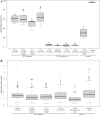Acid scarification as a potent treatment for an in vitro germination of mature endozoochorous Vanilla planifolia seeds
- PMID: 37067667
- PMCID: PMC10110789
- DOI: 10.1186/s40529-023-00374-z
Acid scarification as a potent treatment for an in vitro germination of mature endozoochorous Vanilla planifolia seeds
Abstract
Background: Vanilla planifolia is the most widely cultivated species of vanilla with high economic importance. However, seed germination under artificial conditions is difficult and yields low germination percentages. The seeds are adapted to endozoochorous dispersal, and we therefore tried to simulate the conditions in the digestive tract by acid scarification of seeds.
Results: Immature seeds lacking dormancy, used as a control, showed the highest germination percentage. Among the treatments tested for mature seeds, the hydrochloric acid treatments were significantly the best in breaking dormancy and inducing germination, irrespective of the acid concentration and the presence of pepsin. Conventional treatment with a hypochlorite solution induced much lower germination percentage. Sulphuric acid at concentration 50% was too strong and caused damage to the seeds. Important factor is also high cultivation temperature 30 °C as there was nearly no germination at 25 °C.
Conclusions: Our protocol significantly improves the efficiency of generative propagation of vanilla and allows for significantly higher germination percentages than previously described. The strongly positive effect of hydrochloric acid may be related to the adaptation of seeds to endozoochorous dispersal.
Keywords: Acid scarification; Calcium hypochlorite; HCl; Hydrochloric acid; In vitro cultivation; Orchid; Seed germination; Sulfuric acid; Vanilla planifolia.
© 2023. The Author(s).
Conflict of interest statement
The authors declare that they have no competing interests. The founding sponsor had no role in the design of the study; in the collection, analyses, or interpretation of data; in the writing of the manuscript, and in the decision to publish the results.
Figures


Similar articles
-
Asymbiotic germination of Vanilla planifolia in relation to the timing of seed collection and seed pretreatments.Bot Stud. 2021 May 3;62(1):6. doi: 10.1186/s40529-021-00311-y. Bot Stud. 2021. PMID: 33939032 Free PMC article.
-
First evidence for multimodal animal seed dispersal in orchids.Curr Biol. 2023 Jan 23;33(2):364-371.e3. doi: 10.1016/j.cub.2022.11.041. Epub 2022 Dec 14. Curr Biol. 2023. PMID: 36521493
-
Unravelling the enigma of seed dispersal in Vanilla.Plant Biol (Stuttg). 2021 Nov;23(6):974-980. doi: 10.1111/plb.13331. Epub 2021 Sep 7. Plant Biol (Stuttg). 2021. PMID: 34490689
-
Intraspecific Variation Along an Elevational Gradient Alters Seed Scarification Responses in the Polymorphic Tree Species Acacia koa.Front Plant Sci. 2021 Nov 4;12:716678. doi: 10.3389/fpls.2021.716678. eCollection 2021. Front Plant Sci. 2021. PMID: 34804080 Free PMC article.
-
A Historical Review of the Artificial Pollination of Vanilla planifolia: The Importance of Collaborative Research in a Changing World.Plants (Basel). 2024 Nov 15;13(22):3203. doi: 10.3390/plants13223203. Plants (Basel). 2024. PMID: 39599412 Free PMC article. Review.
Cited by
-
Exogenous Cytokinin Induces Callus and Protocorm-Like-Bodies Formation in In Vitro Root Tips of Vanilla planifolia Andrews.Trop Life Sci Res. 2024 Mar;35(1):235-258. doi: 10.21315/tlsr2024.35.1.13. Epub 2024 Mar 30. Trop Life Sci Res. 2024. PMID: 39262862 Free PMC article.
-
The orchid seed coat: a developmental and functional perspective.Bot Stud. 2023 Sep 27;64(1):27. doi: 10.1186/s40529-023-00400-0. Bot Stud. 2023. PMID: 37755558 Free PMC article. Review.
References
-
- Alomía YA, Mosquera-E AT, Flanagan NS, Otero JT. Seed viability and symbiotic seed germination in Vanilla spp. (Orchidaceae) Res J Seed Sci. 2017;10:43–52. doi: 10.3923/rjss.2017.43.52. - DOI
-
- Arditti J. Factors affecting the germination of orchid seeds. Bot Rev. 1967;33:1–97. doi: 10.2307/4353735. - DOI
-
- Ballard WW. Sterile propagation of Cypripedium reginae from seeds. Am Orchid Soc Bull. 1987;56:935–946. doi: 10.3109/07388551.2013.841117. - DOI
Grants and funding
LinkOut - more resources
Full Text Sources

